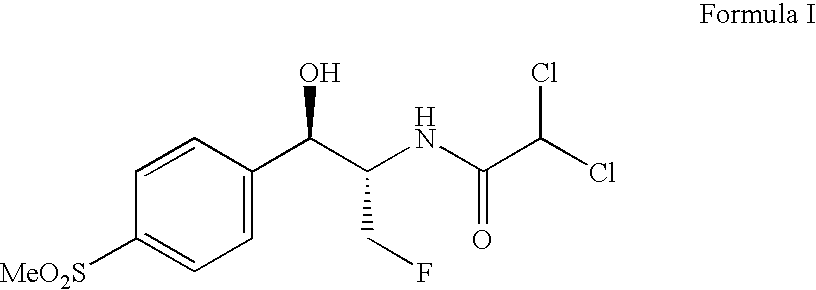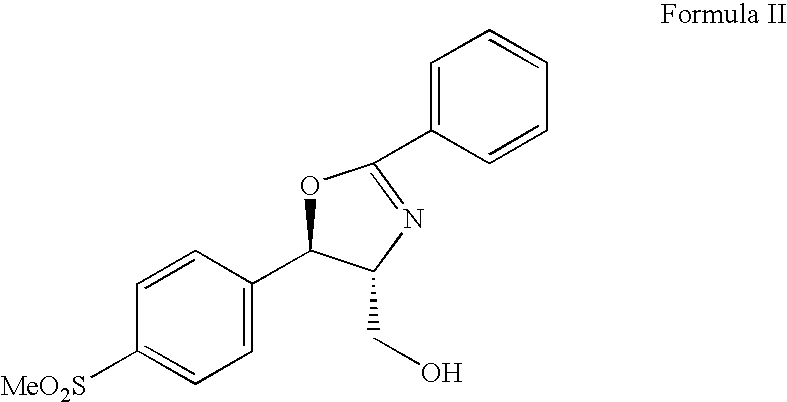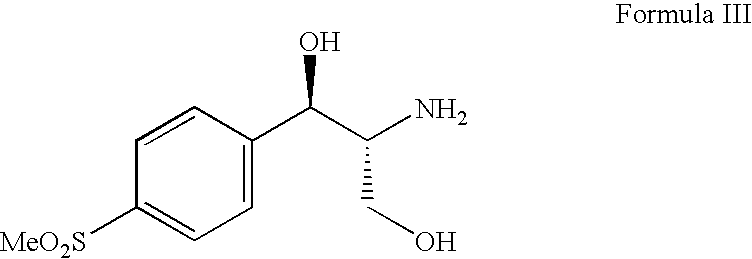Process for preparing florfenicol
a technology of florfenicol and process, applied in the field of process for preparing florfenicol and florfenicol analogs, can solve the problems of low yield of desired oxazoline product obtained using this process, low production of florfenicol, and low purity
- Summary
- Abstract
- Description
- Claims
- Application Information
AI Technical Summary
Benefits of technology
Problems solved by technology
Method used
Image
Examples
example 1
Preparation of (1R,2S)-2-DICHLOROACETAMIDO-3-FLUORO-1-[4-(METHYLSULFONYL)PHENYL]-1-PROPANOL(FLORFENICOL)
STEP-I. Preparation of (4R,5R)-3-Acetyl-2,2-Dimethyl-4-Hydroxymethyl-5-[4 (Methylsulfonyl)Phenyl]-1,3-Oxazolidine(N-Acetyl Oxazolidine)
[0085]A suspension of (1R,2R)-2-amino-1-[4-(methylsulfonyl)phenyl]-1,3-propanediol hydrochloride (50 g, 0.178 mole), triethylamine (35.88 g, 0.355 mole) and acetone (400 ml) were heated at 50° C. to 60° C. for 12 hours. The reaction mass was cooled to room temperature, filtered and the filtrate was evaporated under reduced pressure at 40° C. to 45° C. The mass was dissolved in methylene chloride (450 ml) and to this solution triethylamine (26.91 g, 0.266 mole) and acetyl chloride (15.34 g, 0.195 mole) were added at 10° C. to 15° C. in an inert atmosphere. After completion of the reaction, the reaction mass was washed with 10% w / v aqueous ammonium chloride solution (100 ml) and the organic layer was evaporated to dryness. The residue was dissolved i...
example 2
Preparation of (4R,5R)-3-ACETYL-2,2-DIMETHYL-4-HYDROXYMETHYL-5-[4-(METHYLSULFONYL)PHENYL]-1,3-OXAZOLIDINE(N-ACETYL OXAZOLIDINE)
[0104]A suspension of (1R,2R)-2-amino-1-[4-(methylsulfonyl)phenyl]-1,3-propanediol hydrochloride (50 g, 0.178 mole), triethylamine (35.88 g, 0.355 mole), acetone (250 ml) and toluene (250 ml) were heated at 70–80° C. for 18 hours. The reaction mass was cooled to room temperature, filtered and the filtrate was evaporated under reduced pressure at 40° C. to 45° C. The mass was dissolved in methylene chloride (450 ml) and to this solution triethylamine (26.91 g, 0.266 mole) and acetyl chloride (15.34 g, 0.195 mole) were added at 10° C. to 15° C. in an inert atmosphere. After completion of the reaction, the reaction mass was washed with 10% w / v aqueous ammonium chloride solution (100 ml) and the organic layer was evaporated to dryness. The residue was dissolved in methanol (150 ml) and stirred with potassium carbonate (9.8 g, 0.071 mole) for 30–35 minutes at 20°...
example 3
Preoaration of (4S,5R)-3-ACETYL-2,2-DIMETHYL-4-FLUOROMETHYL-5-[4 (METHYLSULFONYL)PHENYL]-1,3-OXAZOLIDINE (FLUORO OXAZOLIDINE)
[0105]To a suspension of (4R,5R)-3-acetyl-2,2-dimethyl-4-hydroxymethyl-5-[(4-methylsulfonyl)phenyl]-1,3-oxazolidine (10 g, 0.031 moles) in acetonitrile (120 ml) under nitrogen atmosphere, was added (1,1,2,3,3,3-hexafluoropropyl)diethylamine (Ishikawa reagent, 13.65 g, 0.061 moles) in a closed reactor. The reactor was heated at 90° C. to 100° C. for 3 hours. The reaction mass was cooled to room temperature and concentrated under reduced pressure distillation at 40–45° C. to obtain an oily residue. The residue was dissolved in methylene chloride (100 ml), washed with saturated sodium chloride (20 ml) and used as such in the next step.
PUM
| Property | Measurement | Unit |
|---|---|---|
| temperature | aaaaa | aaaaa |
| pressure | aaaaa | aaaaa |
| temperature | aaaaa | aaaaa |
Abstract
Description
Claims
Application Information
 Login to View More
Login to View More - R&D
- Intellectual Property
- Life Sciences
- Materials
- Tech Scout
- Unparalleled Data Quality
- Higher Quality Content
- 60% Fewer Hallucinations
Browse by: Latest US Patents, China's latest patents, Technical Efficacy Thesaurus, Application Domain, Technology Topic, Popular Technical Reports.
© 2025 PatSnap. All rights reserved.Legal|Privacy policy|Modern Slavery Act Transparency Statement|Sitemap|About US| Contact US: help@patsnap.com



